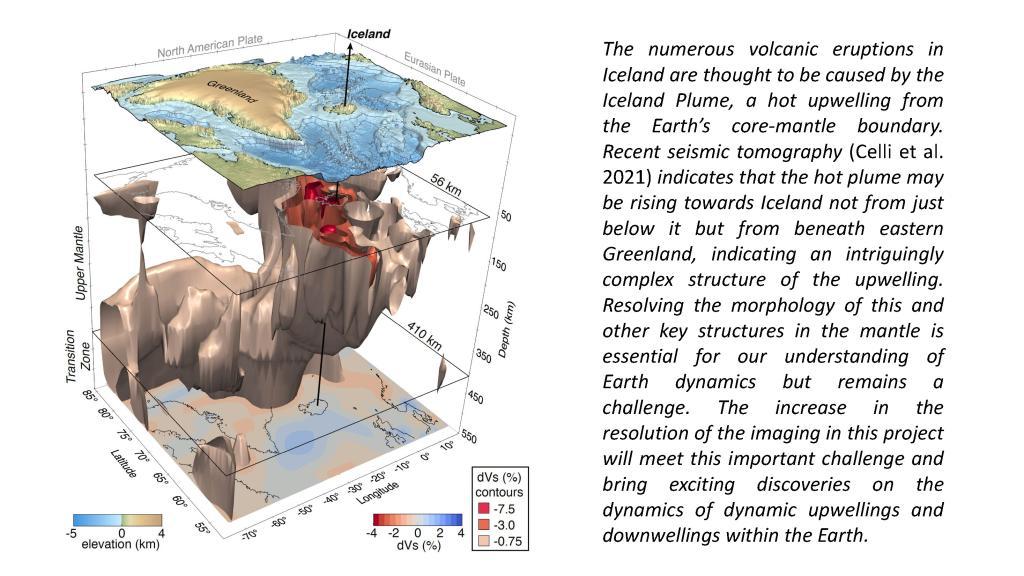
Lead supervisor: Sergei Lebedev, Earth Sciences
Co-supervisor: Nick Rawlinson, Earth Sciences
Brief summary:
Seismic tomography, the principal method of the Earth-interior imaging, has a clear current challenge—addressing it will increase the resolution in the poorly resolved deep upper mantle and bring important new discoveries on Earth structure and dynamics.
Importance of the area of research concerned:
Seismic tomography produces 3D models of Earth interior by using millions of seismograms recorded worldwide and solving large inverse problems. Seismic velocities and their directional dependence (anisotropy) give us unique evidence on the physical structure and deformation of the lithosphere and underlying mantle. The explosive recent growth in the amount of seismic data has created a much denser sampling of the Earth than available only recently. Computationally cheap, asymptotic waveform tomography methods enable us to use all available seismic data, thus maximizing the potential resolution. Yet, the resolution is now limited by systematic errors in the data and modelling. The key current problem is the imprecise modelling of the sensitivity volumes of seismic waves used in tomography. Solving this problems will lead to a significant increase in the resolution of waveform tomography at global and regional scales, in particular in the deep upper mantle including the transition zone (410-660 km depths), which plays a key role in the convection within the Earth.
Project summary :
Mantle plumes—the hot upwellings from the core-mantle boundary—show complex morphology in the mantle transition zone (410-660 km depth). This indicates enigmatic dynamic processes relating to the origin and properties of large igneous provinces, responsible for the major mass extinctions. Unfortunately, the deep structure is difficult to resolve, and current tomographic models struggle at these depths. In order to solve the problem, this project will greatly improve the accuracy of the sensitivity volumes of regional S and multiple S waves, particularly sensitive to the transition zone structure. This will be done by incorporating nearly exact sensitivity volumes of the waves computed with state of the art numerical techniques. The new methods will be applied at the North Atlantic and global scales and yield discoveries on the dynamics of the Iceland and other mantle plumes.
What will the student do?:
The student will have at their disposal a very large global dataset of recorded and inverted seismograms, used to compute today’s state-of-the-art tomographic models. In order to increase the imaging resolution, they will, first, work with the supervisor and co-supervisor Tarje Nissen-Meyer (Oxford, Exeter) on accurate sensitivity volumes (kernels) for regional S and multiple S waves. The waveform kernels will be constructed from the elemental kernels, computed for each sample on the seismogram using Nissen-Meyer’s AxiSEM code. The numerical efficiency of the asymptotic waveform tomography will thus be combined with the accuracy of the spectral-element numerical modelling in a way that will still be efficient enough to be applied to all available data. The methods will be tested and applied at the North Atlantic and global scales, yielding substantial improvements in the resolution of the deep upper mantle. The student will use their new images to gain new insights into the dynamics of the Iceland Plume, other plumes elsewhere, and the enigmatic cold downwellings formed by sinking fragments of the lithosphere.
References - references should provide further reading about the project:
Celli, N.L., S. Lebedev, A.J. Schaeffer, C. Gaina, 2021. The tilted Iceland Plume and its effect on the North Atlantic evolution and magmatism, Earth Planet. Sci. Lett., 569, 117048, doi:10.1016/j.epsl.2021.117048
Lebedev, S., G. Nolet, T. Meier, R. D. van der Hilst, 2005. Automated multimode inversion of surface and S waveforms, Geophys. J. Int., 162, 951-964, doi:10.1111/j.1365-246X.2005.02708.x
Nissen-Meyer, T., van Driel, M., Stähler, S.C., Hosseini, K., Hempel, S., Auer, L., Colombi, A. and Fournier, A., 2014. AxiSEM: broadband 3-D seismic wavefields in axisymmetric media. Solid Earth, 5(1), pp.425-445, doi:10.5194/se-5-425-2014
Applying
You can find out about applying for this project on the Department of Earth Sciences page.